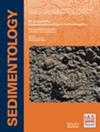Hummocky sedimentary structures within rippled beds due to combined orbital waves and transverse currents
IF 2.6
2区 地球科学
Q1 GEOLOGY
引用次数: 0
Abstract
ABSTRACT Hummocky cross‐stratification is commonly observed in the marine offshore transition to lower shoreface environments. However, to date, the origins of hummocky cross‐stratification and its associated hummocky bedforms and hydrodynamic processes remain controversial and enigmatic. In the present study, a large‐scale flume experiment was conducted to study the formation of hummocky bedforms. In the central test area of the flume, combined flow with water waves, with period of 2 s and velocity of 0.34 m/s, progressed at a right angle to a current with velocity of 0.17 m/s, whereas a wave‐alone condition pertained upstream and downstream of the test area. The combined‐flow ripples in the test area had smaller dimensions than wave ripples, but their cross‐section geometries were very similar. Most importantly, the experimental results, for the first time, revealed that humps occur with lengths up to approximately 40 mm beneath combined flow ripples. The formation of these structures appears to relate to the enhanced turbulence for the combined flow, because the turbulence kinetic energy for combined flow was ca 50% higher than that under the wave‐only condition. Moreover, the observed small‐scale humps in the present experiment had comparable cross‐section geometries with hummock‐like bedforms previously reported in laboratories and fields under storm conditions. Additionally, these humps could scale up to large‐size hummocks under waves with longer period and faster velocity than the present conditions. The present experiment indicates that waves perpendicular to a current do generate hummock‐like structures in association with ripples and therefore provide a new perspective for future study of the origins of hummocky cross‐stratification.由轨道波和横流组合而成的波纹床内的丘状沉积构造
在海洋近岸向低滨面环境的过渡中,通常观察到驼峰交叉分层。然而,迄今为止,丘状交叉分层的起源及其相关的丘状地貌和水动力过程仍然存在争议和谜。在本研究中,进行了大型水槽试验来研究丘状河床的形成。在水槽中心试验区,周期为2 s,流速为0.34 m/s的水流与水波组合以直角方向推进至流速为0.17 m/s的水流,而在试验区的上游和下游均为单波状态。试验区的组合流波纹尺寸小于波浪波纹,但其截面几何形状非常相似。最重要的是,实验结果首次揭示了在组合流波纹下,峰状突起的长度可达约40毫米。这些结构的形成似乎与组合流湍流的增强有关,因为组合流的湍流动能比仅波浪条件下的湍流动能高50%左右。此外,本实验中观测到的小尺度驼峰的截面几何形状与之前在实验室和野外报道的风暴条件下的驼峰状地形具有可比性。此外,在周期更长、速度更快的波浪下,这些驼峰可能会扩大到大型驼峰。目前的实验表明,垂直于水流的波浪确实会产生与波纹相关的丘状结构,因此为未来研究丘状交叉分层的起源提供了一个新的视角。
本文章由计算机程序翻译,如有差异,请以英文原文为准。
求助全文
约1分钟内获得全文
求助全文
来源期刊

Sedimentology
地学-地质学
CiteScore
8.20
自引率
11.40%
发文量
94
审稿时长
6-12 weeks
期刊介绍:
The international leader in its field, Sedimentology publishes ground-breaking research from across the spectrum of sedimentology, sedimentary geology and sedimentary geochemistry.
Areas covered include: experimental and theoretical grain transport; sediment fluxes; modern and ancient sedimentary environments; sequence stratigraphy sediment-organism interaction; palaeosoils; diagenesis; stable isotope geochemistry; environmental sedimentology
 求助内容:
求助内容: 应助结果提醒方式:
应助结果提醒方式:


